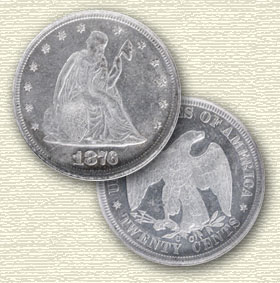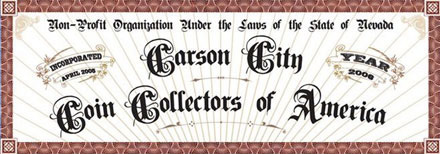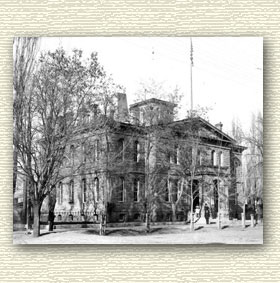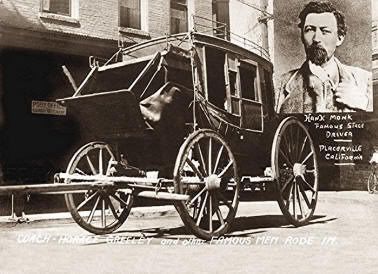- Posts: 176
- Thank you received: 0
1883-C.C. $20 Gold Coin of the Week 6-19-11
14 years 4 months ago - 14 years 4 months ago #2767
by randysc
1883-C.C. $20 Gold Coin of the Week 6-19-11 was created by randysc
In 1883 a man that symbolized an aspect of Western Americana, the stage coach driver, passed from this world. He rests in plot number 25 at the Lone Mountain Cemetery on Roop Street and Beverly Drive in the north central part of Carson City. His name was Hank Monk.
Hank Monk was probably one of, if not the best stage coach driver of his time. Born in Waddington, New York in March 24, 1826, he was driving stage by age 12. In 1852 he came to California and drove stage from Sacramento to Auburn California. In 1857 he ran the Placerville to Genoa Nevada route with runs from Carson City to Virginia City and did so for twenty years. There is the famous story of him giving newspaper editor Horace Greeley the ride of his life across the Sierras. Needing to be at a speaking engagement by 7:00 PM in Placerville, they left at dawn from Genoa. Greeley offered him an extra $10.00 if he would pick up the pace to be sure to get there, of which Monk obliged. At speeds unheard of in crossing the Sierras, Monk cracked his whip and drove the horses as the stage hug narrow roads along cliff sides, running over rocks and ruts in the road that bounced Greeley from one end of the stage to the other. Greeley, upon requesting to slow down as the appointment wasn't worth risking his life, was told by Monk, "Keep your seat, Horace. You'll get there on time." And he did.
Monk died of pneumonia in Carson City February 28, 1883, buried at the Lone Mountain to become part of Carson City history evermore.
Another event on a lighter side that occured in Carson City of 1883 was the election of Jewett Adams as Governor of the State of Nevada. Born in Vermont in 1835, Adams moved West to California in 1851 trying his hand at mining. He ran a general store for a couple of years and was hired as paymaster for the estate of John C. Fremont in 1860. In 1864 he moved to Nevada. From 1874 to 1882 he served as Nevada's Lieutenant Governor and then Governor from 1883 to 1887. He went on to become Superintendent of the Carson City Mint from 1894 to 1898. Even though coinage had stopped in 1893, the mint continued as a refining facility while Adams was at the helm.
The Mint at Carson City was in 1883, while not having a better year in respect to production, was not having a bad one either. As far as production numbers, the face value of coins produced in Carson of 1883 totaled $2,588,030. Nine years would have more in face value and ten years would total less, so it was right in the middle.
It was costing the Mint in Philadelphia of the 1880's 1.3 to 2 cents, less the metal price, per coin to mint. In San Francisco it was 4.5 cents to 6 cents per coin and at Carson City it was 7 to 10 cents a coin. If Carson City were allowed to increase coinage production, cost per coin would go down as it was an average over total production costs, yet the government with their can't see the forest through the trees mentality would not increase production as the costs were too high. It was a paradox. Still mint employee were content in keeping the presses working and the lower numbers worked more favorably for us collectors.
In 1883 of the $2,588,030 face value total production, $1,204,000 was in silver dollars, however 59,962 1883 C.C. double eagles struck totaled a face value of $1,199,240.00, nearly as mich as the silver dollars. Eagles and half eagles totaled up the remaining $184,790. In contrast to the 59,962 C.C. double eagles struck in 1883, San Francisco struck 1,189,000 double eagles. Did the cost per coin issue play into these numbers? Possibly, but in Philadelphia of the same year no double eagle business strikes were produced, only 92 proofs.
Of the 59,962 1883 C.C. double eagles produced, it is estimated that about 1800 survive, putting it around fourteenth out of nineteen on the overall rarity scale. Its availability is fairly easy making it obtainable to most that are just looking for a nice example of a C.C. double eagle to have as a type C.C. double eagle coin. There are none known as of yet that grade higher that MS-63 and little more than a handfull of those exist. About 160 exist in grades MS-60 and above, raw and certified. With another 1450 or so in grades of EF to AU, a nice strong looking grade is not a problem to find, though will likely be bagmarked on the surface lowering the overall eye appeal. Nice examples with minimal bagmarks do exist but will, of course, be costly.
The strike, though better struck in 1882, is still overall above average for the C.C. double eagle. On the obverse strike weakness may show on the brow and in the hair details above Liberty's ear. Some of the stars can show weak radial lines definition also. On the reverse the eagle's feathers in its neck and the lines of the shield can show weakness.
The luster is said to be of average quality on the C.C.double eagle of 1883 with many a dull frosty luster, some even being semi-prooflike. A few full prooflike pieces also do exist. There are a number of 1883 C.C. double eagles that can technically qualify to be uncirculated but because of heavy bag marks and impaired luster have been "net graded" down by the "experts" to AU-50 to AU-55 by major grading companies.
There are two die varieties so far, Variety 1-A has a well spaced and even date, small die lines between the eleventh and twelfth stars on the obverse. On the reverse the C.C.s are closely spaced with some filling seen between the top and bottom loops of both C's. Variety 2-A has the 1 of the date positioned differently to the denticle directly below it and a noticeable raised dot to the right of the middle of the 3.
Prices for the 1883 Carson City double eagle as according to the PCGS price guide are as follows:
VF-30 $2,125 / EF-40 $2,600 / AU-55 $4,200 / MS-60 $7,500
I hope all the fathers had an enjoyable Father's Day today.
-R-
Hank Monk was probably one of, if not the best stage coach driver of his time. Born in Waddington, New York in March 24, 1826, he was driving stage by age 12. In 1852 he came to California and drove stage from Sacramento to Auburn California. In 1857 he ran the Placerville to Genoa Nevada route with runs from Carson City to Virginia City and did so for twenty years. There is the famous story of him giving newspaper editor Horace Greeley the ride of his life across the Sierras. Needing to be at a speaking engagement by 7:00 PM in Placerville, they left at dawn from Genoa. Greeley offered him an extra $10.00 if he would pick up the pace to be sure to get there, of which Monk obliged. At speeds unheard of in crossing the Sierras, Monk cracked his whip and drove the horses as the stage hug narrow roads along cliff sides, running over rocks and ruts in the road that bounced Greeley from one end of the stage to the other. Greeley, upon requesting to slow down as the appointment wasn't worth risking his life, was told by Monk, "Keep your seat, Horace. You'll get there on time." And he did.
Monk died of pneumonia in Carson City February 28, 1883, buried at the Lone Mountain to become part of Carson City history evermore.
Another event on a lighter side that occured in Carson City of 1883 was the election of Jewett Adams as Governor of the State of Nevada. Born in Vermont in 1835, Adams moved West to California in 1851 trying his hand at mining. He ran a general store for a couple of years and was hired as paymaster for the estate of John C. Fremont in 1860. In 1864 he moved to Nevada. From 1874 to 1882 he served as Nevada's Lieutenant Governor and then Governor from 1883 to 1887. He went on to become Superintendent of the Carson City Mint from 1894 to 1898. Even though coinage had stopped in 1893, the mint continued as a refining facility while Adams was at the helm.
The Mint at Carson City was in 1883, while not having a better year in respect to production, was not having a bad one either. As far as production numbers, the face value of coins produced in Carson of 1883 totaled $2,588,030. Nine years would have more in face value and ten years would total less, so it was right in the middle.
It was costing the Mint in Philadelphia of the 1880's 1.3 to 2 cents, less the metal price, per coin to mint. In San Francisco it was 4.5 cents to 6 cents per coin and at Carson City it was 7 to 10 cents a coin. If Carson City were allowed to increase coinage production, cost per coin would go down as it was an average over total production costs, yet the government with their can't see the forest through the trees mentality would not increase production as the costs were too high. It was a paradox. Still mint employee were content in keeping the presses working and the lower numbers worked more favorably for us collectors.
In 1883 of the $2,588,030 face value total production, $1,204,000 was in silver dollars, however 59,962 1883 C.C. double eagles struck totaled a face value of $1,199,240.00, nearly as mich as the silver dollars. Eagles and half eagles totaled up the remaining $184,790. In contrast to the 59,962 C.C. double eagles struck in 1883, San Francisco struck 1,189,000 double eagles. Did the cost per coin issue play into these numbers? Possibly, but in Philadelphia of the same year no double eagle business strikes were produced, only 92 proofs.
Of the 59,962 1883 C.C. double eagles produced, it is estimated that about 1800 survive, putting it around fourteenth out of nineteen on the overall rarity scale. Its availability is fairly easy making it obtainable to most that are just looking for a nice example of a C.C. double eagle to have as a type C.C. double eagle coin. There are none known as of yet that grade higher that MS-63 and little more than a handfull of those exist. About 160 exist in grades MS-60 and above, raw and certified. With another 1450 or so in grades of EF to AU, a nice strong looking grade is not a problem to find, though will likely be bagmarked on the surface lowering the overall eye appeal. Nice examples with minimal bagmarks do exist but will, of course, be costly.
The strike, though better struck in 1882, is still overall above average for the C.C. double eagle. On the obverse strike weakness may show on the brow and in the hair details above Liberty's ear. Some of the stars can show weak radial lines definition also. On the reverse the eagle's feathers in its neck and the lines of the shield can show weakness.
The luster is said to be of average quality on the C.C.double eagle of 1883 with many a dull frosty luster, some even being semi-prooflike. A few full prooflike pieces also do exist. There are a number of 1883 C.C. double eagles that can technically qualify to be uncirculated but because of heavy bag marks and impaired luster have been "net graded" down by the "experts" to AU-50 to AU-55 by major grading companies.
There are two die varieties so far, Variety 1-A has a well spaced and even date, small die lines between the eleventh and twelfth stars on the obverse. On the reverse the C.C.s are closely spaced with some filling seen between the top and bottom loops of both C's. Variety 2-A has the 1 of the date positioned differently to the denticle directly below it and a noticeable raised dot to the right of the middle of the 3.
Prices for the 1883 Carson City double eagle as according to the PCGS price guide are as follows:
VF-30 $2,125 / EF-40 $2,600 / AU-55 $4,200 / MS-60 $7,500
I hope all the fathers had an enjoyable Father's Day today.
-R-
Last edit: 14 years 4 months ago by randysc.
Please Log in to join the conversation.
14 years 4 months ago #2769
by Belayoff
C4OA Lifer!
Replied by Belayoff on topic Re:1883-C.C. $20 Gold Coin of the Week 6-19-11
Randy,
A thoroughly enjoyable and informative posting about the 1883-CC Double Eagle.
Where in the world did you learn about the stage coach driver though??
Belay Off
A thoroughly enjoyable and informative posting about the 1883-CC Double Eagle.
Where in the world did you learn about the stage coach driver though??
[img size=400]
i788.photobucket.com/albums/yy166/BelayOff/1883-CC20MS63.jpg
[/IMG size]
1883-CC Double Eagle MS-63
Photo From PCGS Coin Facts
Belay Off
C4OA Lifer!
Please Log in to join the conversation.
14 years 4 months ago - 14 years 4 months ago #2770
by Carsonite
C4OA Lifer!
Replied by Carsonite on topic Re:1883-C.C. $20 Gold Coin of the Week 6-19-11
Randy,
You have showed, in your COTW posting, how important it is to interject history-related facts and anecdotes in the coverage of the coins that were made at the Carson City Mint. After all, if a person is going to learn about coins made in Nevada, he or she should seek to learn as much as possible about that state—It makes collecting so much more interesting.
You gave us glimpses into Hank Monk's colorful life. Mark Twain in "Roughing It" (Twain's first famous book), immortalized Hank Monk when he described the celebrated drive by which Monk whisked Horace Greeley to Placerville, CA.
And you shared pertinent information above Nevada's fourth governor Jewett W, Adams. You made significant comparisons among the various mints' coinage productions, and you made the following astute observation:
Rusty
You have showed, in your COTW posting, how important it is to interject history-related facts and anecdotes in the coverage of the coins that were made at the Carson City Mint. After all, if a person is going to learn about coins made in Nevada, he or she should seek to learn as much as possible about that state—It makes collecting so much more interesting.
You gave us glimpses into Hank Monk's colorful life. Mark Twain in "Roughing It" (Twain's first famous book), immortalized Hank Monk when he described the celebrated drive by which Monk whisked Horace Greeley to Placerville, CA.
Hank Monk with his hat
Stagecoach similar to Hank Monk's famous "Tally Ho"
Hank Monk's gravesite at Carson City's
Lone Mountain Cemetary
Lone Mountain Cemetary
And you shared pertinent information above Nevada's fourth governor Jewett W, Adams. You made significant comparisons among the various mints' coinage productions, and you made the following astute observation:
Very good job; and I liked the way you separated your paragraphs with spaces: It gives your article a professional appearance.Nine years would have more in face value [than the 1883-CC double eagle] and ten years would total less, so it was right in the middle.
Rusty
C4OA Lifer!
Last edit: 14 years 4 months ago by Carsonite. Reason: Centering
Please Log in to join the conversation.
14 years 4 months ago #2771
by Belayoff
C4OA Lifer!
Replied by Belayoff on topic Re:1883-C.C. $20 Gold Coin of the Week 6-19-11
Aha! No wonder. I've never read Roughing It. Thanks for answering my questing about this interesting fellow Hank Monk.
Belay Off
Belay Off
C4OA Lifer!
Please Log in to join the conversation.
- Loosechange
- Offline
- Platinum Member
-

- Married to my best friend!
Less
More
- Posts: 504
- Thank you received: 0
14 years 4 months ago #2773
by Loosechange
Go "CC'S"
Replied by Loosechange on topic Re:1883-C.C. $20 Gold Coin of the Week 6-19-11
Excellent article Randy. Very informative and a great special touch profiling a man of the times Mr. Monk. The interesting stories he could tell.
Loosechange
Loosechange
Go "CC'S"
Please Log in to join the conversation.
14 years 4 months ago #2777
by randysc
Replied by randysc on topic Re:1883-C.C. $20 Gold Coin of the Week 6-19-11
Belay-
I have known about Hank Monk since I was a teenager. He is a very unique and interesting figure. Time-Life books put out a series on the American West and one volume on "The Expressmen" has more bio on him.
Carsonite-
I think it compliments a highlighted C.O.W. issue with some dates and a little insight on significant people who are associated with that year's issue. I believe that there is a relationship between coins and history which is one reasons (and a main one) why I'm so fond of coin collecting. To hold a coin like the 1883 C.C. double eagle, you have a direct tie with that year. The wind that brushed the faces of people of that time, blew across the surface of that coin, sunlight that brightened a day from that year, made the luster dance on the surface of that coin, and now that coin from those days past, rests in possession of someone like me on this date, today. Its incredible to think about, especially with Carson City coins.
Loosechange-
Thank you for your complement. And I believe you're right. Mr. Monk would indeed have some very interesting stories to tell, and I'll bet he would be most willing to tell them. Thanks again.
-R-
I have known about Hank Monk since I was a teenager. He is a very unique and interesting figure. Time-Life books put out a series on the American West and one volume on "The Expressmen" has more bio on him.
Carsonite-
I think it compliments a highlighted C.O.W. issue with some dates and a little insight on significant people who are associated with that year's issue. I believe that there is a relationship between coins and history which is one reasons (and a main one) why I'm so fond of coin collecting. To hold a coin like the 1883 C.C. double eagle, you have a direct tie with that year. The wind that brushed the faces of people of that time, blew across the surface of that coin, sunlight that brightened a day from that year, made the luster dance on the surface of that coin, and now that coin from those days past, rests in possession of someone like me on this date, today. Its incredible to think about, especially with Carson City coins.
Loosechange-
Thank you for your complement. And I believe you're right. Mr. Monk would indeed have some very interesting stories to tell, and I'll bet he would be most willing to tell them. Thanks again.
-R-
Please Log in to join the conversation.
Time to create page: 0.124 seconds





